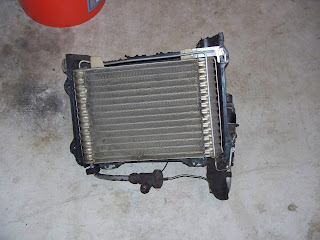I am ready. I am ready for the machining.
When last we met, I was in the garage taking the heads off. Well, I had to put them back on temporarily, as well as the intake manifold so I could lift the engine with the hoist once again. I did this to remove the flywheel off the back of the engine. In order to really get the bolts off the flywheel I had to wedge a large screwdriver into the teeth of the flywheel and brace it against the rest of the engine so it wouldn't move when I was torquing on the bolts. I'd have taken a picture of it, but both hands were full at the time.
Flywheel came off, put the engine back on the stand. Took off all the external bits, like the motor mounts, main pulley etc. Rotated the engine over, so the bottom is facing up, then took off the oil pan to reveal the crankshaft.
Note the tool stuck in the crankshaft. It's there to prevent the crank from turning when I was undoing the bolt that holds the harmonic balancer (round orange thing on the far right in the above photo) to the crank. Also note the oil pump (tall black thingy poking up on the far left in the above photo).
To get the harmonic balancer off, I had to buy a special tool that fits onto the bolt holes previously occupied by the main pulley assembly. Then you screw in a large main bolt that presses into the crankshaft and pulls off the harmonic balancer.
Well what I didn't know is that the crankshaft bolt that was in there before, was very close in size to the large black bolt in the above picture, so when I was twisting it in there, it was getting threaded into the crank... oops
 |
| Don't do it this way. |
Screwing in those three brass-colored bolts, about 3 full turns each in a loop until the balancer came off.
Then I removed the power steering fluid reservoir.
After that the timing chain cover came off, and the cam-shaft timing chain sprocket (it's the bigger one... I forgot to take a photo). Then I could pull the cam shaft out. See it on the green towel there?
The cam shaft is like the brain of the engine, it tells the engine when to "breathe in" fresh air and "exhale" bad air.
Then it was onto taking the pistons out of the cylinders. With the engine still upside-down, you can rotate the crankshaft (using the same bolt that held the harmonic balancer on the front, and a socket wrench) until two pistons are at "bottom dead center" that is they are all the way down in the cylinder. Then undo the two nuts that hold the bottom of the piston rod to the crankshaft.
When those two bolts are off, I had to put the wrench against a small flange on the cap, and hit the wrench with a hammer a few times to dislodge the cap from the rod.
 |
| Cap removed. |
The fuel line acts like a shield protecting the cylinder wall from getting damaged by the extraction of the pistons and rods.
 |
| Just seven more to go. |
Repeat the procedure to get all the pistons out. Now, if you intend to reuse the pistons and rods you currently have, you'll want to label each one with a number punch. Label the rod in the first cylinder 1, the second 2 etc. Also you'll want to label the caps of each as well, so you don't get them mixed up.
Here's a diagram of the piston numbers and firing order (shown in the circle).
I'm getting all new pistons and rods, so I didn't care much. I need new parts because they will bore out each cylinder to be bigger than they originally were. The machine shop will make enough room for 383 cubic inches of displacement (total volume the piston will travel through), from the 350 I currently have.
 |
| All pistons out. |
Then pulled out the "water jacket" plugs (see the brass colored discs in the above link). Each cylinder is surrounded by a jacket of water to keep it cool. The engine block is a hollow chamber that allows for water to circulate around the parts that need to be kept cool.
Then removed some of the "oil gallery" plugs, but I stripped one. Finally, I put a 1/4" wide 3' long steel rod down in through the newly opened oil gallery plug hole (which runs the length of the engine) in order to push agains the tap-in oil plugs on the front of the engine, and hammered them out.
I now am ready to take the parts to the machine shop.
Does anyone know what to do with lifters/pistons/crankshafts/camshafts etc. that you're not using anymore? I mean they have to be worth *something*, yeah?


































